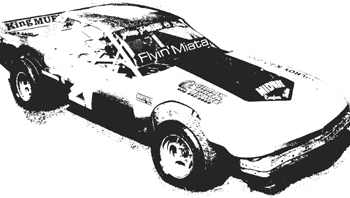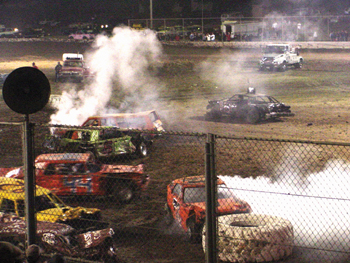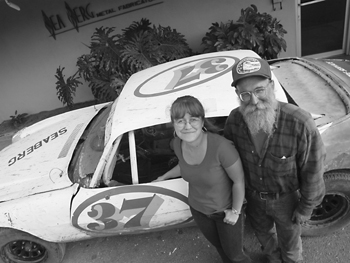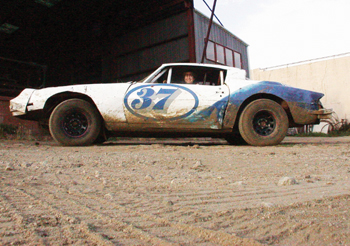![[Metroactive Features]](http://metroactive.com/features/gifs/feat468.gif)
[ Features Index | Santa Cruz | Metroactive Home | Archives ]
Start Me Up
Welcome to the Watsonville Speedway! Speedway! Speedway! It's motorized mayhem! mayhem! mayhem! when Metro Santa Cruz throws its unsuspecting reporter into the metal-crunching, mud-flinging, needles-in-the-red, maximum-overdrive world of local racing. Everyone, start your engines!
By Mike Connor
They call it a dirt track, but by lap 70 of a 250-lap Enduro race, there is no more dirt on the track at all. It starts out nightmarishly wet and clumpy, forcing the drivers to keep their speed down. Still, collisions are happening everywhere. Some of the cars spin out of control and get stuck in the mud, completely helpless as the rest of the drivers careen past them. Everyone is struggling for some semblance of control out there, but I watch with mounting anxiety as the 60-some cars on the track pack it down into an unsettlingly flat and sticky paste--perfect for driving fast.
I am not ready for this.
I've raced go-carts before. I've driven dune buggies, dirt bikes and street bikes so fast that I forgot to breathe until I put on the brakes. I've even jumped out of a couple of perfectly good airplanes. But as I stand behind a fence just inches from the track at the Watsonville Speedway--about to drive on a dirt track for the first time, in a car I've never even sat in, with drivers that do things I've only seen in movies--doctors and porn stars alike would be amazed to see my balls retreat up into my esophagus.
And it's all happening in a place a lot of people don't even know exists. Since 1954, the Watsonville Speedway has butted right up against the SC County Fairgrounds. The quarter-mile-high-bank oval track is known for excellent driving conditions and a variety of events--its weekly racing series features NASCAR-sanctioned races and a whole slew of local Speedway events (see sidebar).
The track attracts devoted fans and casual spectacle-seekers alike. It has its heroes, its villains and really tasty junk food. Pros and do-it-yourselfers hobnob in the pit area each and every week, risking their necks and pocket books for a rush of adrenaline and, if they're lucky, a few moments of precious adulation.
And then there's me--a reporter wandering around haplessly, trying to make sense of the organized chaos in the pit area, who just so happened to stumble upon an opportunity to drive in the Enduro race.
The Enduro is a bit of an anomaly on the schedule in that it runs a whole lot longer than most races--250 laps or two hours, whichever comes first. It's a great race for beginners because it's relatively low-speed, due to congestion; there have been as many as 99 cars on the 1/4-mile track at once. Tractor tires serve as obstacles on a choppy track full of cars that mostly qualify as beaters, keeping things even slower.
Truth be told, you'd be lucky to break 50 mph on the straightaway. Which sounds pretty pokey until you're actually flying around the track, skidding in between an overheated car and a not-going-anywhere wall.
The Setup
Going into tonight, I had a tip that a guy named Chris Messmer would be orchestrating an unusual feat in the Enduro: 25 drivers in one car. I was picturing clowns in a Volkswagen as I walked over to talk with Messmer in the pit, but I quickly realized the drivers would rotate. I still had no idea I would be one of them.
Messmer was wearing a T-shirt, Hawaiian shorts and Birkenstocks--not exactly the typical image of a race-car driver. He was friendly, talked fast and got straight to the point. I asked him how he got into racing.
"Coming out as a fan about 14 years ago," Messmer said, "I was watching one night and said to my wife, 'Next year I'm gonna be out there racing.' She said, 'Well, whatever.'"
Six years later, Messmer now holds the track record for the fastest qualifying time in the Street Stock division, and he's third place in points this year. He also enjoys enabling his friends to race in the Enduro, his goal being to get as many people to race as possible.
"We're not here to win the race," said Messmer with a smile, "we're just here to have fun."
He explained that the team would lose about three laps every time the car stopped for a driver change. But with so many chances for a pit crew to keep the cars running cooler, Messmer's entries tend to hold up throughout the whole Enduro. That's more than anyone can say for, oh, about 80 percent of other Enduro cars.
"Even with all the driver changes, we came in 11th place last time simply because we completed more laps than everyone but 10 other cars," said Messmer.
He also explained that he'll let anyone who wants to drive in one of his cars. And before I could fully accept where the conversation was headed, he had offered to let me and my photographer drive in the evening's Enduro race, provided that we had long-sleeve shirts and could fit into one the helmets. The word "yes" just sort of tumbled out of my mouth.
Just like that, I was set to race--balls creeping ever upward.
The Warm-up
Throughout the night, I get the chance to take in several of the other competitions. The Rollover Contest is probably the most insanely absurd event at the Speedway, but it's not really racing. Neither is the Destruction Derby, which is just as fun and almost as nuts. No, when it comes to actually racing, the craziest event of all is the gratuitously dangerous Figure 8. As if driving cars around an oval at high speeds with other cars around wasn't exciting enough, someone went and threw an intersection into the mix.
It's a huge crowd-pleaser, even for jaded city folk. Ironic detachment is impossible when 3,000-pound cars are hurtling toward one another, sometimes slamming together in the "X" like something out of Faces of Death. It's a rare, crazy breed of people out there. 25-year-old Figure 8 racer Kim Gillespie is one of them.
She's been coming out to the track to watch her father, Jim Gillespie, race since she was 4 years old. At 25, she's unusually petite and steadfastly outspoken.
"For the longest time I wanted to be a trophy girl," Kimi says, "but then one day I decided that I wanted to be the one standing next to the trophy girl--the one getting the trophy."
Thus began young Kimi's racing career. At 16, she was working on her father's car in the pit. At 18, she was in the driver's seat, starting out on American Stocks around the oval. The very next season she and six other female racers hit the Figure 8 one day, and three of them never stopped.
Why? Because, as Kimi puts it, "The oval's boring!"
Her father elaborates: "I like the Figure 8 because there's a lot of finesse involved," he says. "It's a matter of timing. When you approach the X, you have to know who's coming, how fast and whether you're going to fit. My motto is always, 'Don't stop in the X,' and 'A car goes through a much smaller hole at [high] speed.' We call it 'threading the needle.'"
I think I've got a better name for it: flirting with death.
"You can't race the Figure 8 without having serious collisions," says Jim. "I've been T-boned in the X. I've been spun around and hit head-on. I crashed into the front wall really hard one time. I have a picture at home where I'm standing up almost vertical on the guardrail. It was one of those nights that didn't go too well."
Both drivers are very forthcoming about their exploits on the track, but when the subject of interfamilial collisions comes up, they tiptoe around it.
"Kimi and I have actually come together in the X on more than one occasion," Jim says enigmatically. When I ask Kimi for more details about what happened, Jim pipes up again: "What happened was that Daddy came home and had to fix both cars."
The Inspiration
Judging by the night that I saw him win the American Modified race, Bobby Scott is pretty much the Jeff Gordon of the Watsonville Speedway. He's been the reigning champ in the track's premier division for three years running, shooting for an unprecedented fourth consecutive championship. He's a family man. He's personable and has a good presence on the microphone in the winner's circle. In short, he's a star--a modest, self-effacing one, but whether he'll admit it or not, the crowd loves him.
"It's a pretty tight group of people out there," Scott explains. "You have a lot of friends and family, and then you have fans who come on board at some point that like you, and all of a sudden they're your fan, and they wear your shirt and they're there every week to cheer you on. It makes it cool, you know? For a Friday night, you get to feel maybe a little bit how Jeff Gordon or someone like that at the top gets to feel on Sunday. Fans come back afterwards to hang out and talk with you. Little kids sit in your car and put your helmet on and look at the gauges. You can hear people cheering for you. It's pretty cool."
A 12-year veteran of the track, and heir to Scott's Auto Body in Santa Cruz, Scott and his crew have the maintenance thing down pat, spending only about three hours a week on it. He looks at racing more as a social event for his family and friends.
"I think for me it's still a hobby; I'm not really looking to make a profession out of it. Running out here is OK with me--there's good competition and the racing's fun. I can race on a Friday night, my family can watch, and on Saturday morning I can wake up and make pancakes and go to the park."
Scott works at the body shop; Jim Gillespie owns Sebring Metal Fabricators. But what about those of us who don't get to mix business with racing? How can we possibly afford it?
Demolition Derby and Enduro enthusiast Frank Larsen says he built a derby-ready car for $400 and about a week's "labor of love." All it takes, he says, is a serious gutting, installation of roll bars and a few other minor alterations outlined in a one-page list of specs on the Speedway's website (www.watsonvillespeedway.com). Larsen's first was a demolition derby car that he just knew was going to take the other apart.
"I lasted about 15 seconds before I got slammed and my battery caught on fire," says Larsen. "It was jarred loose and landed on the floor next to me burning, and I was hanging my head out the window because there was all this acidy smoke inside the car. But you look outside and think, 'Should I jump and run?' and you see all these cars smashing outside around you--that wouldn't be a safe place to be, right? And then finally someone hit me again and jolted the fire out."
He's since switched to Enduro racing, which is actually almost as dangerous. Sure, they'll stop the race in the event that the track is completely blocked by an accident, or if a driver is injured or on fire, but outside of that, you're on your own.
The Big Event
"If you can't drive it in, you just gotta sit there," Messmer councils me in a prerace pep talk. I don't feel too peppy. Instead, I feel my testicles shriveling even further as I wait for my turn to get behind the wheel of Messmer's banged-up Oldsmobile.
It's been gutted and reinforced with a heavy-duty roll cage. From straight on, it looks like it has a lazy eye--the right front wheel is bent in at a cowardly angle, as if the tire were trying to roll underneath the center of the car where it would be safe from all the carnage. But above all, this car is beat to hell. The frame looks like crinkled-up aluminum foil.
It breaks down before I ever get to drive it.
Instead, I end up in Messmer's beat-up Monte Carlo, complete with a Camaro fender bent up into a permanent snarl. It's dark outside as I climb in through the window of the car and fumble around for the seat belt. I can hardly reach the pedals, and realize belatedly that I have no mirrors to work with, as I'm waved onto the track.
See Connor Go: Check out a 14-second video of our reporter wreaking havoc in the beat-up Monte Carlo (QuickTime .mov file).
And then there I sit, perched on the edge of the berm at the far bend of the track. The words "holy shit" come to mind when I first see the other cars tearing around the bend and jockeying for position below me. I'm frozen for a moment like a deer in headlights--then a hole opens up and I stomp on the gas, tipping myself over the berm right in front of an oncoming car.
Fortunately, the Monte Carlo has some guts, rocketing me down the straightaway. Cars are on all sides of me as I go skidding around the bends, scraping door-to-door against the other racers, dodging tractor tires and cars that are stuck in the mud or overheated.
I manage to complete my five laps without any serious collisions, which is amazing considering that I pretty much suck. I fishtail practically the whole time, grossly overcompensating like a midget with a megaphone. At one point, I cut off the leader with my erratic driving. And in the one and only skillful move I make "threading the needle" between a broken-down car and a tractor tire, I cause a four-car wreck behind me.
It is, without a doubt, one of the coolest things I've ever done.
Flushed with adrenaline when it's all over, I have no question in my mind as to why these people spend so much time and money to keep up a rather expensive habit. The rush rivals any drug--the thrill of speed, the dicey X-factor of slippery mud, flying around a bend alongside another car, metal clanking and scraping against metal--it's enough to keep even the most voracious thrill-seeker chomping at the bit for more.
If I had to guess, I'd say I raced for about 15 minutes. But a stopwatch doesn't lie: 5 minutes and 12 seconds. I know I could do better though. I just need another chance.
Later, I call Messmer, wondering if he takes bribes.
"It's conceivable, one could charge people to drive," Messmer says, "but I'd just rather let everyone do it for free. Anybody who shows up, if they have a long-sleeve shirt, I wouldn't rule out the possibility that they'd get to race. Maybe you could put a coupon in the paper," Messmer laughs, taunting me despite the obvious desperation in my voice.
Anybody out there got a beater with a roll cage for sale?
An outsider's quick-reference guide to all those crazy divisions
By Mike Connor
American Stocks
Street Stocks
Grand American Modified
Figure 8
Dwarf Cars
Enduro
Destruction Derby
Rollover Contest
A beginner's guide to racing at the Watsonville Speedway
By Mike Connor
Bobby Scott on Getting Started: "The rush of being out there and racing, the door-to-door competition is intense. That's what keeps you going; you want to get better and do more, and it's kind of cool because they have the different divisions out there. The Enduro, that's probably the perfect, cheap way for anybody to get started. For four or five hundred dollars, you can go run an Enduro race and get an idea what it's like to race against other people. You don't have to worry about cops--street racing just gets people in trouble. Out there we can go do it and have a good time in a controlled environment. This is NASCAR's hobby level of racing, so to speak, so they don't have any requirements other than purchasing a NASCAR license. We're like step one for NASCAR--you start out here to gain experience, and then you can go onto one of NASCAR's touring series. But out here, there's no requirements by NASCAR of any kind of driving test that you have to take. It's just buy a license and go! Anybody can do it."
Chris Messmer on Enduro Driving: "Start off kinda slow, work up to it slowly. Don't go balls out in the first turn. The goal is to finish the race, not win it. Look ahead--it's hard to change direction. Don't let yourself get pushed towards the place where everyone else is stopped. And once you're stopped, it's hard to get going again. You've got to think ahead--you don't want to lose momentum. If you're having problems with your car, get to the infield. I've been plowed so hard I got a concussion. It's considered bad form to take out another car, but in this race it's expected you're going to rub a little bit."
Kim Gillespie on the Figure 8: "You go out, you race as many laps as you think you can handle and then you go off, and if you think you can hang it out to the end, you stay on the track. There's no training session--it was, 'we're going green, get on the track, if you don't wanna be there, get off!' That's just the way it is! And we decided to go out for the race, and that was it. I wanted to do Figure 8 every week."
Bobby Scott on Racing Technique: "I go down the straightaway with the throttle on, and then you get off the throttle and tap the breaks to get the wheels to start sliding. It breaks the traction and you start sliding into the corner. You start countercorrecting to control it, and then you pick up the throttle at the time where it feels right and the thing's getting traction. Then you're on the gas through the corner and out on the straightaway until it straightens back out again. That's what you're doing--for 30 laps you're just controlling the slide."
Jim Gillespie on Safety: "You've got a helmet, a three-layer fire suit, you've got a halon fire bottle in there if perchance you do have a fire--you just pull on the handle and it blows off the halon and fills up the whole car to snuff out the fire. And they have a great safety crew at Watsonville. I broke my transmission off a couple weeks ago, and a little oil went out in the exhaust and it lit on fire, and they were right on it, right there puttin' the fire out."
[ Santa Cruz | Metroactive Central | Archives ]
Copyright © Metro Publishing Inc. Maintained by Boulevards New Media.
![]()

Photographs by Stephen Laufer

Speedway to Hell: Speedway enthusiasts aren't shy about pushing their cars to the limit--or into other cars--night after night.

The High-Speed Collisions That Love Built: Kimi Gillespie and father Jim like to take each other on in the totally insane Figure 8 races.
![[line]](/gifs/line.gif)
![[line]](/gifs/line.gif)
For a complete schedule of Watsonville Speedway events and rules, visit www.watsonvillespeedway.com.

Names and Races
Standard stock-car racing on a 1/4-mile-high-bank dirt track. Beware of mud flying into uncovered beer in the stands near turn No. 1.
Stock cars with some racing modifications allowed. Faster and more intense than American Stocks.
The track's featured division, these custom racing cars look like souped-up dune buggies. Fastest, fanciest cars on the track.
High-speed dirt track racing + intersection = quality entertainment.
One-man miniature roadsters powered by 1100 cc GSXR motorcycle motors. Fast-paced and adorable.
250-lap race on a muddy, torn-up track filled with banged-up beaters. Lots of low-speed accidents.
Hilarious free-for-all--last car moving wins. Please, do not hold small children up to the fence so they can see better unless you want them permanently augmented with derby debris.
Just like it sounds: drivers launch one side of their car off narrow ramp to flip their car as many times as possible. Totally kooky.

Tips From the Pros
From the August 6-13, 2003 issue of Metro Santa Cruz.